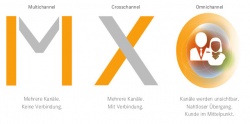On the Omnichannel Area especially young, innovative companies will be presenting current omni-channel solutions specifically for retailers while in the adjacent Omnichannel Forum experts will share practical tips for getting one’s company into shape for all channels and seamless networking. After all, if your customers are not vigorously demanding these new services today, it won’t be long before they do. But what exactly does omni-channel mean and how does it relate to such things as multi-channel or cross-channel?
Multi-channel: several channels – no connection
When e-Commerce emerged and digital sales channels were established in the form of web shops multi-channel distribution saw the light of day. Dealers are no longer just selling via one, mostly physical channel but also via other channels – however without any connection between these systems. Online and offline sales can be handled completely separately in organisational terms. Even a consistent brand appearance in the form of Corporate Designs, for example, is not necessarily a given.
Cross-channel: several channels – connected
Unlike with multi-channel retail cross-channel retail enables a connection between several channels. The link between physical stores and web shops brings about entirely new distribution models such as online reservations and/or orders for bricks-and-mortar outlets. Conversely, purchases and orders can be made offline while the goods are shipped to shoppers.
Omni-channel: channels become invisible – seamless transition
The next step from cross-channel retail is omni-channel: the seamless customer journey across all channels, with a flowing transition and consistent brand experience. It is occasionally difficult to distinguish cross-channel from omni-channel operations since there are no hard facts like there are to distinguish between multi- and cross-channel retail. Instead, it is the shoppers’ impression during their retail trip that decides – and, hence, a soft factor that is also determined by the quality of implementation. A case in point here is a service like Click & Collect which cannot be clearly categorised as a cross or omni-channel range. In omni-channel retail processes running in the background are no longer visible for shoppers. Their shopping experience is seamless without any obstacles – and without focusing on any specific channel.
Omni-channel service set as a standard
For the EHI study “Omnichannel-Commerce 2015” 25 retailers from Germany, Austria and Switzerland were personally interviewed on the challenges and level of implementation of omni-channel services. Five services proved pivotal here for omni-channel implementation: online availability updates for offline products, Click & Collect with online payment as well as the possibility for offline payment, in-store returns and in-store orders. The interviewed retailers stated that in-store ordering was the service most frequently implemented and offered – for example, with tablet solutions for sales assistants and shoppers. The least frequently implemented service was Click & Collect with in-store payment since here products that have not been paid for by the shopper have to be reserved for a prolonged period.
Omni-channel retail in Germany, Austria and Switzerland

In Switzerland and Austria the situation is similar. Over two thirds of the 250 best-selling web shops in Austria offer their shoppers at least one multi-channel retail experience. 45.2% of the web shops offer at least multi-channel, either via TV (tele shopping), print (catalogue) or domestic physical outlets, and 24.4% of retailers link their web shop with a physical store and are therefore engaged in cross or omni-channel retail. Taken together 69.6% of the top 250 web shops are involved in multi-channel activities. Of the top 250 web shops in Switzerland 25.6% offer their customers a link between online and offline stores, offering cross or omni-channel commerce. 38.8% of the web shops are engaged in multi-channel activities, either via TV (tele shopping), print (catalogue) or domestic physical stores. This means that 64.4% of the 250 retailers rely on multi-channel options.
UK Retailers are Pioneers
Among the retailers polled for the “Omnichannel-Commerce 2015” study the United Kingdom plays a pioneering role in Europe when it comes to omni-channel solutions and user acceptance, while implementation of these services still seems to be in the early stages in Germany. An analysis of local studies underlines this impression: over two thirds (73%) of British online shoppers have not only used Click & Collect services – 75% of these online shoppers are also very satisfied with the implementation of the services, as a study by eDigitalResearch and IMRG shows.
A survey conducted by Verdict polling 10,000 British consumers in March 2015 shows that omni-channel solutions can also serve as drivers for bricks-and-mortar retail: here 32% of the shoppers polled said that they had purchased additional products when collecting their Click & Collect order.
Source: Messe Düsseldorf GmbH





